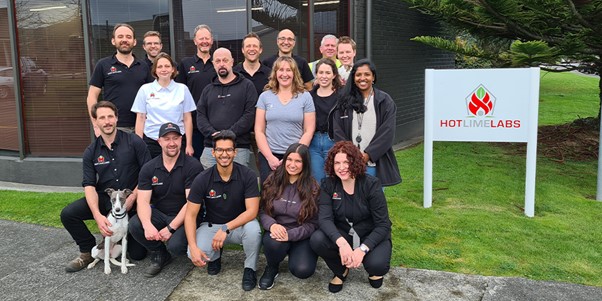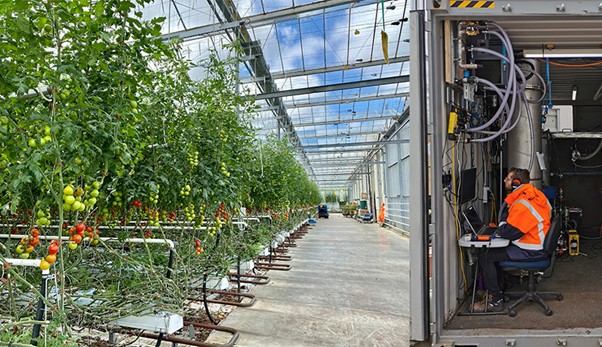
“…the climate’s not going to become more predictable; land prices aren’t going down and the demand for fresh fruit and vegetables is not going to reduce. These trends are only going in one direction and CEA and greenhouses are going to be a vital part of the future of food.”
— Tijs Robinson, Hot Lime Labs
Dr Vlatko Materic is another academic who has turned his expertise into a commercial opportunity, in his case meeting the huge unmet demand for clean carbon dioxide (CO2) in the greenhouse industry. The company he founded, Hot Lime Labs, is developing technology that enables greenhouses to be more productive, efficient and sustainable by providing cheaper, cleaner CO2. It didn’t start out that way. Materic’s focus was originally on how to capture carbon, not create it.
He researched carbon capture systems for thermal power plants for over a decade at the former government research institute, Industrial Research Limited (now Callaghan Innovation). The technology showed great promise but the power plant stakeholders Materic talked to weren’t interested in paying for something with compelling environmental benefits but little or no commercial upside.
Materic was lost in the wilderness trying to figure out what to do next when he stumbled upon the connection between CO2 and greenhouses. He was on a tour of a greenhouse and the owner was talking about how they would love to figure out a way to access more CO2. Sensing an opportunity, Materic jumped on a plane to Europe to research the concept where his hunch was confirmed.
He set up Hot Lime Labs in Wellington in 2017 with support from a number of investors, including Tijs Robinson, now the company’s Chief Growth Officer. Robinson’s task is to engage with customers and investors to finance what is a capital intensive technology.
“It’s hard to be a nimble startup when you’re manufacturing big pieces of equipment worth up to a million dollars,” says Robinson. “We need a lot of capital and New Zealand doesn’t have deep capital reserves. Investors are more likely to put their money into a software company where they might get a return in six months.”
“The other challenge is the depth of talent available. Kiwis are super smart and super innovative but we’ve only got a population of five million people compared to 750 million people in Europe. It’s hard to find skilled talent in our specific area of expertise but we’re lucky to have a business and a vision that gets people excited and we’ve managed to attract amazing staff so far.”

Greening the greenhouses
“We put the green back in greenhouses,” says Robinson. “Green means renewable, so we’re looking at moving CO2 production away from fossil fuels and into green energy. Green also stands for greenbacks or dollars; we make growers more money by reducing their energy costs and increasing yields.”
Currently, most greenhouses use natural gas to generate the CO2 they need to feed their plants. In New Zealand and worldwide, there’s a push to move away from fossil based fuels to more renewable sources. The Russia-Ukraine war has caused massive disruption to the natural gas supply in Europe and led to massive price spikes around the world. Hot Lime Labs solution is to extract CO2 from biomass, including wood and waste materials from greenhouses.
“Growers around the world want to shift away from natural gas but they need an alternative source of CO2,” explains Robinson. “It’s a vital ingredient in growing crops and plants. In a greenhouse you can optimise the temperature and humidity.”
“You can eliminate pests and microdose the plants with the right nutrients. You can control all of the growing variables except CO2 which is often the limiting variable in greenhouses. If plants don’t get enough CO2 they go into stress mode and become less productive. But if growers can access more CO2 they can increase their yield by 20 to 30 percent.”
Surfing the wave
The Hot Lime Labs prototype capture system converts wood waste into clean CO2 because there’s an endless supply of wood chips in New Zealand. The company is also developing their system to use other forms of biomass, including green waste from greenhouses — for example tomato vines.
“We’ve jumped on the wave at the right time,” says Robinson. “The world is looking for clean, green solutions; the climate’s not going to become more predictable; land prices aren’t going down and the demand for fresh fruit and vegetables is not going to reduce. These trends are only going in one direction and CEA and greenhouses are going to be a vital part of the future of food.”
“We’ve got a product that solves a lot of problems. It can be the catalyst or enabler for wholesale energy transition. By 2030, we want half the world’s greenhouses to create their own supply of sustainable CO2 using our technology. We want to make a huge impact on reducing carbon emissions but it has to make economic sense first. That’s our guiding principle. The environmental impacts are a beautiful by-product.”